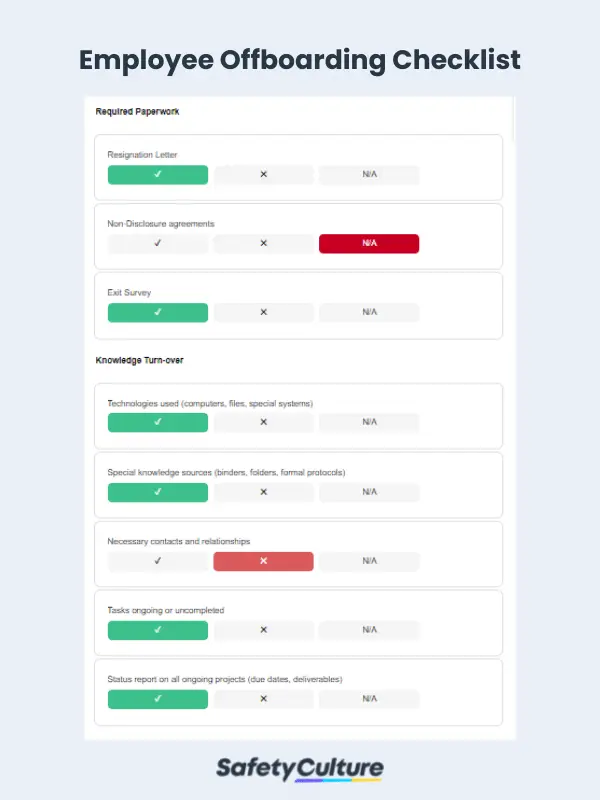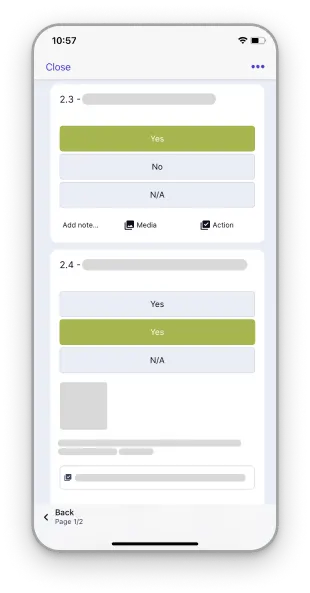What are Employee Offboarding Checklists?
Employee offboarding checklists are tools that help Human Resources (HR) professionals ensure a seamless separation for departing employees either through resignation, termination, or retirement. Not having an employee offboarding process can expose organizations to legal, security, and reputational risks.
What are the Steps in the Employee Offboarding Process?
There is no specific set of steps and chronology when it comes to employee offboarding processes since they vary depending on the company’s policies, required paperwork, and the employee’s role within the company. However, most offboarding processes observe a general set of steps including the following actions:
- Transition and document the status of ongoing projects (if any)
- Gather all the employee’s belongings and return any company property
- Collect the employee’s ID, keys, and other physical access to the company
- Disable the employee’s account and email address
- Update the employee’s contact information in the company’s systems
- Revise the organization chart to reflect relevant changes
- Inform the employee’s colleagues and supervisor of their departure
- Finalize the employee’s exit paperwork
Why is Employee Offboarding Checklist Important?
Employee offboarding can be difficult and complicated, especially if there is a lot of paperwork and procedures to go through. A well-crafted employee offboarding checklist can help to ensure that nothing is overlooked and that the process goes as smoothly as possible.
Ready-to-use checklists or employee offboarding templates can also help protect the company from potential lawsuits by ensuring that all the necessary steps have been taken to properly conclude the employee’s ties to the organization.
Top 5 Benefits of Using Employee Offboarding Checklists
Performing activities that gives organizations an opportunity to gain honest feedback from employees who are resigning, terminated, or retiring—helps them identify areas of improvement that they can continually work on.
Using employee offboarding checklists can help ensure a great work environment and help HR department/s and teams:
1. Minimize Error and Oversight
Overlooking crucial steps of the offboarding process can lead to incomplete paperwork , administrative errors and compliance violations. The use of offboarding checklists can help HR professionals keep track of offboarding requirements like critical paperwork (i.e. Non Disclosure Agreements), knowledge and project handover requirements and transfer of company assets.
2. Mitigate Legal Risks
Not having a comprehensive audit trail for leaving employees opens organizations up to potential litigation. Even employees who initially leave on good terms could be disgruntled in the future and make unfair dismissal claims. Having a structured offboarding process with the use of checklists can remind your HR teams to follow the correct legal steps when offboarding departing employees.
3. Manage IT Security Risks
Failure to retrieve company equipment and switch off data access for employees who are on the process of departure can pose serious risks of data breach for an organization. HR teams should consult IT departments to determine what equipment and access should be retrieved or which confidential information should be secured. Checklists can also be helpful when asking employees to declare that all access has been returned.
4. Ensure Seamless Handover
Without proper knowledge transfer, the remaining employees would suffer. It could cause confusion, low work productivity and in extreme cases, teams starting in scratch. An employee offboarding checklist is an effective way to ensure that departing employees do not leave until they have transferred login access, guidelines, strategy planning and their contact details in the event of future team inquiries.
5. Build Positive Reputation
Disgruntled departing employees can cause negative reviews, lower employee morale and damage employer branding. Conducting exit interviews can help ensure departing employee voices are heard and help HR teams identify areas for improvement. Continuously monitoring insights through offboarding checklists also helps prevent high turnover rate. Employees who leave on good terms and feel their concerns have been heard may return in the future or at the very least not vocally disparage your organization.
What to Include?
Employee offboarding checklists should include all the measures that need to be taken to ensure the employee’s departure is smooth and doesn’t leave any loose ends. As previously mentioned, this can vary according to the specifications of the employee’s role, department, and the business itself—but the important items in checklists include the below:
- Employee details such as position title, department, last day, and address
- List of required paperwork
- Knowledge turn-over like contacts, files, uncompleted projects
- List of company assets to be retrieved such as laptops, phones, credit cards etc.
- Recovery of administrative access and implementation of data security measures
- Acknowledgement and signature from employee and supervisor/manager
FAQs About Employee Offboarding
The first thing to do is recover any tangible assets provided by the company to the offboarding employee, such as desktops, laptops, or mobile phones. Then, make sure to remove all access to company apps, documents, and logins, whether they be individual or shared.
Conduct an exit interview or exit survey, where you emphasize that honest feedback is encouraged. You can use this as a basis for identifying areas for improvement. Additionally, being in a remote setup, it is ideal to schedule a video call with the employee to thank them for their work to still provide a personal touch to the experience.
Employee offboarding documents include a letter of resignation, certification of employment (if requested), non-disclosure agreements (if any), and other important records, such as benefits files and tax-related documents.


